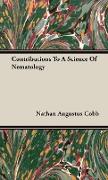Contributions to a Science of Nematology
BücherAngebote / Angebote:
Originally published in 1914. CONTRIBUTIONS TO A SCIENCE OF NEMATOLOGY. Contents include: I. Antarctic Marine Free-Living Nematodes of the Shackleton Expedition II. North American Free-Living Fresh-Water Nema- 1 todes III. The Asymmetry of the Nematode Bunonema in- Z5 equale, n. sp IV. Selachinema, a New Nematode Genus with Remark- 101 able Mandibles 113 V. Notes on Nemas VI. The Mononchs, a Genus of Free-Living Predatory 117 Nematodes VII. Filter-Bed Nemas Nematodes of the Slow Sand 129 Filter-Beds of American Cities 189 VIII. The Orders and Classes of Nemas IX. One Hundred New Nemas 213 Type Species of 100 New Genera 217 X. Howardula benigna, a Nemic Parasite of the Cucumber-Beetie 345 XI. Marionella 353 XII. Greeffiella 359 XIII. An Amendation of Hoplolaimus Daday 1905 nee auctores 363 XIV. Notes on Paratylenchus, a Genus of Nemas . . . 367 XV. Biological Relationships of the Mathematical Series 1, 2, 4, etc 371 XVI. Nemic Spermatogenesis XVII. The Screw Nemas, Parasites of Codfish, Haddock 375 and Other Fishes 388 XVIII. Ungella secta n. gen. n. sp., a Nemic Parasite of the Burmese Oligochaete Earthworm .... 394 XIX. A New Species of the Nemic Genus Syringolaimus. 398 XX. The Chromatropism of Mermis subnigrescens . . . 403 XXI. Survey of Nemas in Marine Beach Sand XXII. The Ambulatory Tubes and Other Features of the 411 Nema Draconema cephalatum XXIII. Observations on the Morphology and Physiology 413 of Nemas XXIV. The Demanian Vessels in Nemas of the Genus 419 Oncholaimus 423 XXV. Metoncholaimus pristiurus Zur Strassen. . . . 439 XXVI. A Key to the Genera of Free-Living Nemas . . . 451 87184 ANTARCTIC MARINE FREE-LIVING NEMATODES OF THE SHACKLETON EXPEDITION Contributions to a Science of Nematology I BY N. A. COBB With fifty illustrations in the text BALTIMORE WILLIAMS WILKINS CO. 1914. ANTARCTIC MARINE FREE-LIVING NEMATODES OF THE SHACKLETON EXPEDITION l. Nematodes are so frequent in the Shackleton collections as to prove the seabottoms of the farthest south to swarm with these little beings. Hundreds of them, male, female and young, were taken from a mere thimbleful of the dredgings. The same tale comes from stations wide apart. Countless myriads find sustenance in these cold dark depths, and must in their turn be devoured by larger forms, until the series culminates in herds of seal and schools of whale. All that in them is, takes on added meaning Whence do these nematodes derive their sustenance The stomachs of a number of the species contain diatoms with such regularity as to leave no doubt that these microscopic plants constitute a main food supply. The undigested frustules of the diatoms are voided and go to make up the permanent sea floor, so that the interesting little creatures whose portraits follow, or at least a part of them, assist in building what some future epoch may disclose as dry land formations of diatomaceous earth as remarkable as those of the United States or those of Tripoli. Some of the other species appear to be predacious, though none belong to the truly carnivorous group of the Enoplidae. No doubt the greater part of the species are vegetarian. These antarctic species are on the whole somewhat smaller than those of warmer seas, but one of them, that mentioned last, is a veritable 1Nematology a contraction of Nematodology. The founding of this branch of science, on a par with Entomology for example, is fully justified by the fact that the Nematodes constitute such a distinct and highly characteristic group of organisms, containing an enormous number of species readily susceptible of division into definite Orders, some of which are of great economic importance.
Folgt in ca. 15 Arbeitstagen




